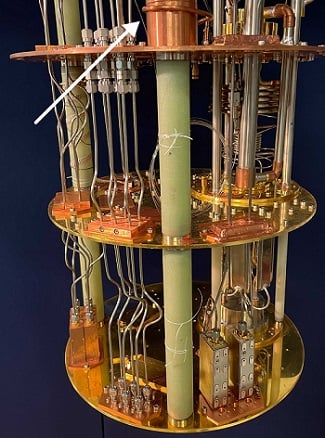Physicists at the National Institute of Standards and Technology (NIST) measured and controlled a superconducting qubit using optical fiber rather than metal electrical wires. The work paves the way to being able to pack a million qubits into a quantum computer rather than just a few thousand and introduces the possibility of a universal quantum computer capable of solving the most difficult equations.
Superconducting circuits are a leading technology for making quantum computers because they are reliable and easily mass produced. But these circuits must operate at cryogenic temperatures, and schemes for wiring them to room-temperature electronics are complex and prone to overheating the qubits. Conventional cryostats — supercold dilution refrigerators — with metal wiring can support only thousands of qubits at the most.

NIST physicists measured and controlled a superconducting qubit using light-conducting fiber (indicated by arrow) instead of metal electrical cables. The work introduces a new approach to universal quantum computing capable of solving the most difficult equations. Courtesy of Lecocq/NIST.
Optical fibers, due to their ability to carry high volumes of signal without conducting heat, are an attractive alternative to metal wiring. However, superconducting quantum computers use microwave pulses to store and process information, which means the light must be converted precisely to microwaves.
To solve this problem, the researchers combined a fiber with additional standard components that convert, convey, and measure light at the level of individual photons, which could then be easily converted into microwaves. The system operated as well as metal wiring and maintained the qubits’ fragile quantum states.
Optical fiber can also carry far more data in a much smaller volume than conventional cable, said John Teufel of NIST’s Advanced Microwave Photonics Group.
Microwave pulses are typically generated at room temperature and delivered through coaxial metal cables to cryogenically maintained superconducting qubits. The setup developed at NIST instead guided light signals via optical fiber to cryogenic photodetectors that converted the signals back into microwaves and delivered them to the qubit. By applying a particular microwave frequency, researchers showed the ability to drive the qubit between low energy and excited states (1 or 0 in digital computing). These states are based on the number of Cooper pairs — bound pairs of electrons with opposite properties — that have “tunneled” across the junction.

The team conducted two types of experiments, using the photonic link to generate microwave pulses that either measured or controlled the quantum state of the qubit. The method is based on two relationships. The first is the frequency at which microwaves naturally bounce back and forth in the cavity — called the resonance frequency — depends on the qubit state, The second is the frequency at which the qubit switches states, and it depends on the number of photons in the cavity.
The team started both types of experiments with a microwave generator. To control the qubit’s quantum state, electro-optic modulators converted microwaves to higher optical frequencies. These light signals streamed through optical fiber from room temperature to 4 K (−269 °C) down to 20 mK where they landed in high-speed semiconductor photodetectors, which converted the light signals back to microwaves, which were then sent to the quantum circuit.
In these experiments, the researchers sent signals to the qubit at its natural resonance frequency to put it into the desired quantum state. The qubit oscillated between its ground and excited states when there was adequate laser power.
To measure the qubit’s state, the researchers used an infrared laser to launch light at a specific power level through the modulators, fiber, and photodetectors to measure the cavity’s resonance frequency.
They first started the qubit oscillating with the laser power suppressed, and then used the photonic link to send a weak microwave pulse to the cavity. The cavity frequency accurately indicated the qubit’s state 98% of the time — the same accuracy as obtained using the regular coaxial line.
The team envisions a quantum processor in which light in optical fibers transmits signals to and from the qubits, with each fiber having the capacity to carry thousands of signals to and from the qubit.
The research was published in Nature (www.doi.org/10.1038/s41586-021-03268-x).
*This article has been updated for accuracy.